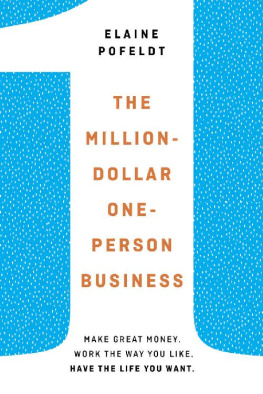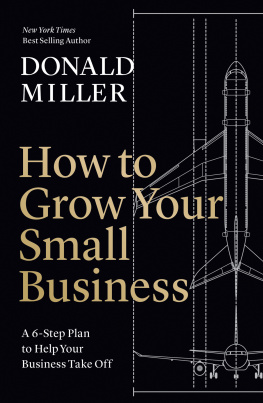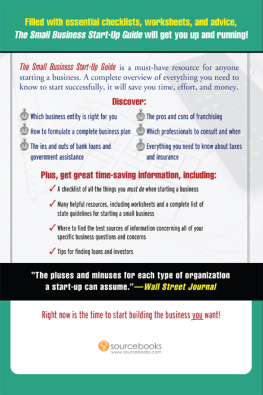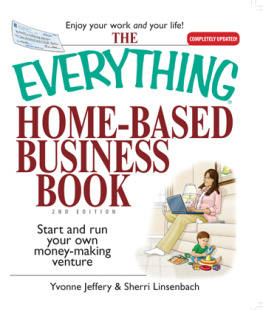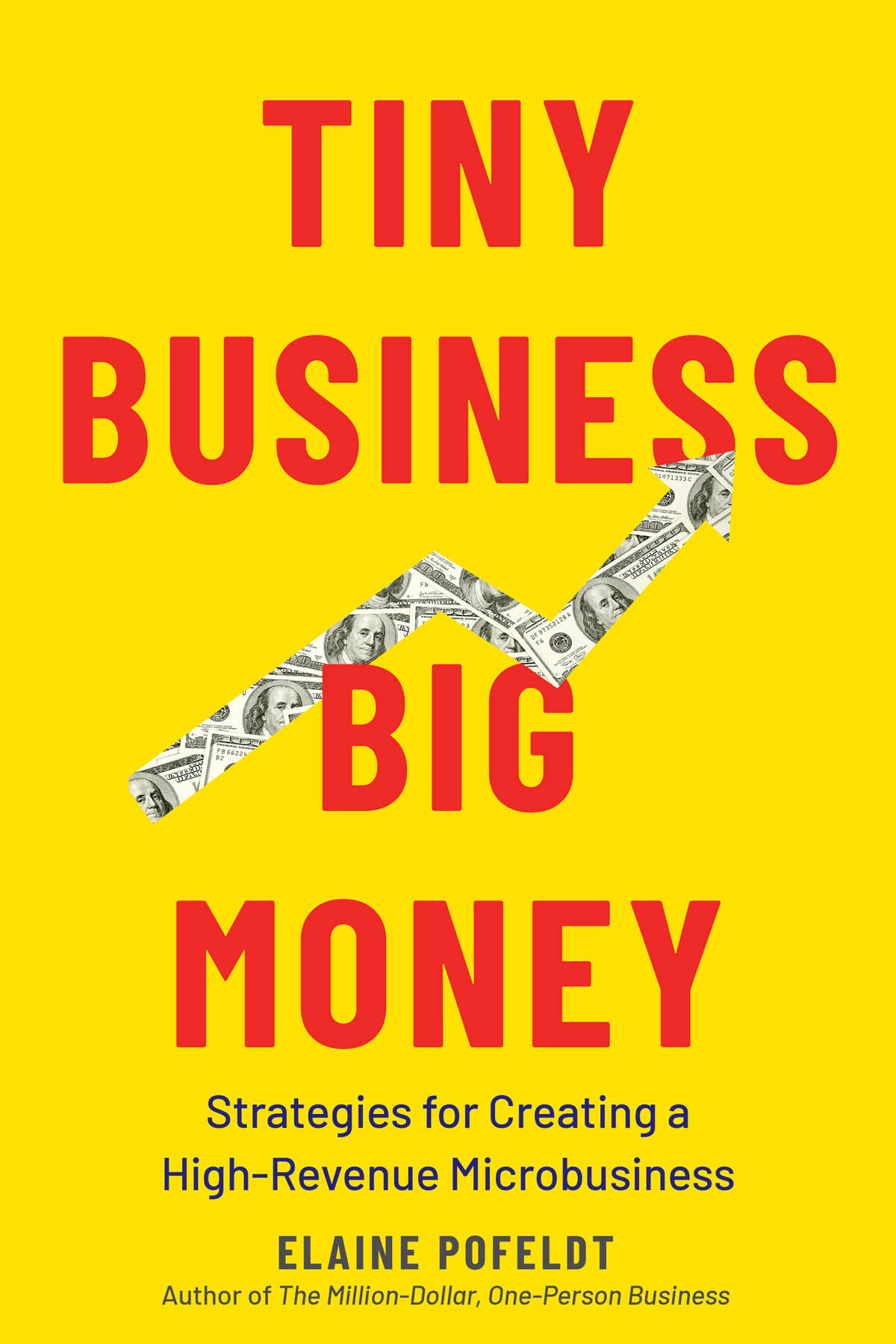Contents
Guide
Page List

Strategies for Creating a
High-Revenue Microbusiness
ELAINE POFELDT

To my family, for inspiring me to take the leap
into running my business and to try a way of life that
I had no idea I would love this much.
Copyright 2022 by Elaine Pofeldt
Foreword copyright 2022 by Verne Harnish
All rights reserved
For information about permission to reproduce selections from this book, write to Permissions, The Countryman Press, 500 Fifth Avenue, New York, NY 10110
For information about special discounts for bulk purchases, please contact W. W. Norton Special Sales at specialsales@wwnorton.com or 800-233-4830
Production manager: Devon Zahn
Library of Congress Cataloging-in-Publication Data is available
The Countryman Press
www.countrymanpress.com
A division of W. W. Norton & Company, Inc.
500 Fifth Avenue, New York, NY 10110
www.wwnorton.com
eISBN: 978-1-68268-644-7
CONTENTS
Verne Harnish, Founder, Entrepreneurs Organization
Theres never been a better time to start and grow a business. As the world opens up after the COVID-19 pandemic, new opportunities are proliferating around the world. Many businesses can now be run from virtually any location. Its no wonder weve seen a record number of new business formations in recent months.
The challenge for many entrepreneurs is deciding where to focus their energy. There are riches in niches, but youve got to find the right one. Tiny Business, Big Money will help you do that, offering a detailed analysis of census data that highlights the industries that offer the biggest upside for microbusinesses with less than twenty employees, as well as the results of an original survey highlighting the best practices of nearly fifty entrepreneurs running the profitable seven-figure businesses that are profiled in this book.
These entrepreneurs have taken their businesses a step beyond the solo founders that Elaine Pofeldt profiled in The Million-Dollar, One-Person Business. They operate with very small teams, made up of either a consistent group of freelancers or a handful of employees. Youll learn how to set yourself up for success from their stories, with actionable strategies on how to develop the right mindset to create a business like this yourself; how to discover your ideal tiny business; how to find the money you need to start and grow it; how to connect with your first customers; and more. Running a tiny business that makes big money is ultimately about leveraging whatever resources you bring to the table for the best possible results.
Once you know how to create the foundations of a tiny business that makes big money, youll have many options in front of you. Some owners will decide to keep their businesses at a boutique size. Others will find they want to take their business as far as they can go, and join the companies that have used the Scaling Up system for growing a company that I described in my book, Scaling Up: Rockefeller Habits 2.0. Both routes can help you achieve the one thing that drives all entrepreneursfreedomwhile allowing you to make a positive difference for your employees, your community, and the world beyond.
Every day during the COVID-19 pandemic, my main escape from the Zoom calls in my home office was a daily walk. From the first days of the crisis to the lifting of the mask mandate for vaccinated people, I followed my route through the local downtown, whether it rained, the temperature hit 100 degrees, or I was sliding on ice or climbing over snowbanks. Im a journalist, and I wanted to see what was happening for myself.
Many days, I took pictures so I wouldnt forget the details laterthe signs of temporary store closures, announcements about new takeout and drive-up services, notices about reopening and the PPE customers would need to wear. During the winter, when I headed out a few hours after the morning darkness, I saw people huddled outside of restaurants, eating in the cold next to heat lamps, trying to support local businesses that were fighting to survive. Sometimes, when going out of business signs appeared in the windows of longtime family businesses, I cried. I run a business, and Ive interviewed thousands of business owners over the years. I knew how hard they had worked to realize their dreams, and how some of them had fought to hang on.
Many of the businesses that made it to the other side were still trying hard to recover from the pandemic as I wrote the last pages of this book.
I had to ask myself if it still made sense to encourage people to start small businesses, after what we had been through. Did I really believe it was worth it?
And the answer, in my heart, was an emphatic yes.
Because, as hard as this latest crisis was for small business owners across America and around the world, there was still opportunity for people who want to earn a living in their own quirky way, with no boss and a blank slate for how to run things. Although many businesses had closed, just as in the Great Recession, others had thrived, and new ones were already sprouting up in some of the empty storefronts. With the pandemic lifting, restaurants near my home were getting crowded. Seeing people milling around outside, eager to see each other again, was a reminder of how important each small business is to the fabric of our communities and how much they are part of the glue that holds us together.
Meanwhile, lots of people had spent the pandemic building or growing thriving e-commerce businesses. US business formations skyrocketed by nearly 42 percent in 2020, as people put their time under lockdown to use in reinventing their careers. Investors were racing to buy the tiniest, home-based operations to create a stable of e-commerce brands. Clearly, I wasnt the only one who was seeing opportunity.
I am a former senior editor at Fortune Small Business magazine and have contributed to CNBC, Fortune, Forbes, Inc., and many other publications. I also wrote TheMillion-Dollar,One-Person Business, where I looked at the growing number of nonemployer businessesthose with no employees on payrollthat were hitting seven-figure revenue. Solo businesses often get ignored or even viewed as a nuisance, but it was clear there was an untold story about how much they could accomplish.
Tiny Business, Big Money looks at another greatly overlooked sector of small businesses: microbusinesses with just a few employees on payroll or that rely on a regular team of contractors who function as a cohesive team. Although all of the owners risk failure, they also have the potential for great success, as youll see from the census data at the center of this book. You may be surprised to see which types of businesses topped the list of small businesses with the most cash left over after they make payroll, on average, in the charts in the appendices. Sometimes, the tiny businesses that bring in revenue in the high six and seven figures are very visible. Others, in true millionaire-next-door style, are churning out profits in a nondescript building or office on the side of the busy routes where we barely notice them (or, increasingly, in their home offices), doing work we seldom think about. Many, I found, are leading very creatively fulfilling and financially rewarding lives. To find out how the founders and owners in these pages uncovered the right businesses, grew them, and built the small teams that drive them, youll be able to tap in to insights from interviews with nearly seventy entrepreneurs in more than sixty businesses.


